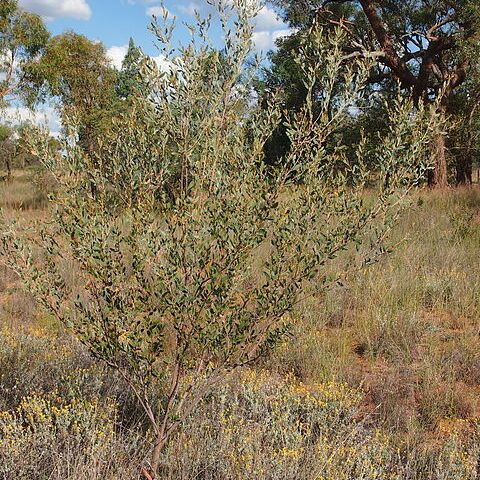Shrub 2-6 m high, bushy, often multistemmed, rounded. Bark longitudinally fissured, with small flakes, light to dark grey. Branchlets terete, densely to sparsely puberulous. Stipules broadly triangular, c. 1 mm long, dark brown. Phyllodes narrowly elliptic, flat, straight or shallowly incurved, 3.5-9.5 cm long, (7-) 10-15 (-20) mm wide, with mucro to 1.5 mm long, ±coriaceous, ±glabrous to densely puberulous; main nerves 2 or 3, longitudinal, more prominent; minor nerves finely reticulate; glands 1-5, marginal, reniform-depressed. Peduncles 1-5 mm long, puberulous. Spikes paired in phyllode axils, 2-5 cm long, dense, bright yellow. Flowers 5-merous; calyx 0.8-1 mm long, dissected to 1/2, membranous, pubescent; corolla 1.2-1.5 mm long, slightly pubescent. Pods linear, ±subtorulose, straight to ±curved, 5.5-13.5 cm long, 3-4 mm wide, densely pubescent, later glabrous. Seeds longitudinal, narrowly oblong, 4.5-5.5 mm long, dark brown; areole 0.9-1 mm long.
More
A small shrub 2-3 m high. The young shoots are hairy and red. The leaves (phyllodes) are 2-5 cm long by 0.6-1.4 cm wide. They are oblong and curved. They are leathery and sticky. They are dark green and have a small hook at the tip. At the base of the leaves there is a clearly seen bract like attachment. It is brown. The flower heads are rods. They are 2.5-5 cm long. Many occur and they are bright yellow. The flower stalk is hairy. The pods are 5-7 cm long by 0.2-0.3 cm wide. They are twisted and leathery. The pods are hairy. The seeds have a reasonably soft coat.
Found in red sandy soils and loam in tall open shrubland, woodland, and open sites where spinifex grasses are abundant.
More
It grows in the northern part of Australia. It gets killed by summer fires. It can grow in arid places.
Grows in red sandy soils and loam in scrub or woodland, often with spinifex.
Can be grown by seedlings. Seeds needs soaking.


